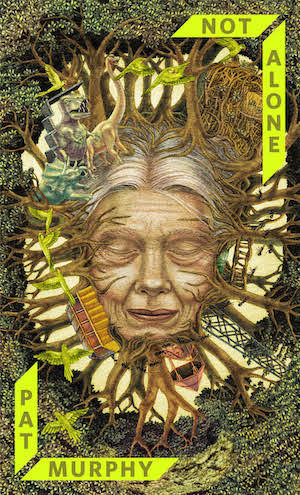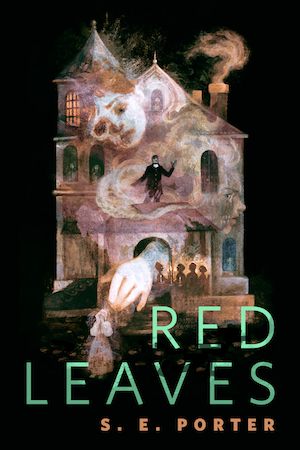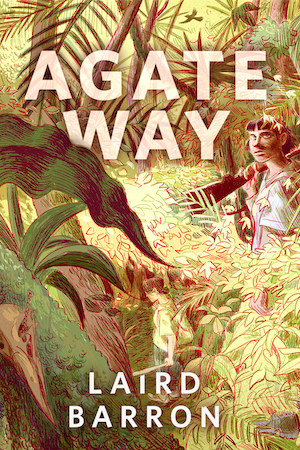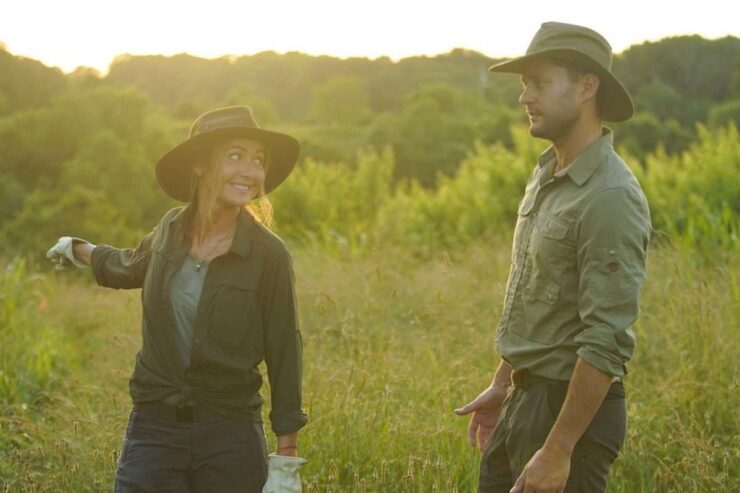In my exploration of cryptids on television, I’ve passed by Expedition X in favor of MonsterQuest and In Search of Monsters. They’ve often covered the same topics, and it seemed like a little too much duplication of effort. After the disappointing MonsterQuest episode on the Ozark Howler, I went back and watched Expedition X, and I’m glad I did.
This was a rewatch of an episode that aired in 2019, which means it got lost in the memory hole of Before the Pandemic. I had forgotten how satisfying it was. Believe it or not, they may have found at least one candidate for the identity of the Howler.
Expedition X is a Josh Gates project. It’s an offshoot of his series, Expedition Unknown, in which he investigates historical and archaeological mysteries. Here, he calls in a pair of younger investigators, and instructs them to look into topics too weird or out there for the main show.
It comes across as a reality version of The X-Files, but genderswapped. The believer is a woman and a paranormal investigator. The skeptic is male and a biologist. The boss sends them all over the place to investigate, basically, X-Files.
Usually they don’t find anything, but they get to do cool experiments with cool gear and talk to witnesses and explore unusual and often remote locations. This time, they actually get results. That’s rare in the world of TV cryptozoology.
In this episode, Jess and Phil interview the same couple who appeared in In Search of Monsters. This time there’s no photo, just the audio. We find out that the wife, Sharon, is a retired professional animal trainer. So, not exactly a lay person. She knows what coyotes and foxes sound like, and can identify the neighborhood dogs. She can’t say what she and her husband recorded on a couple of occasions, including a session that went on for a good forty-five minutes.
The show gives us a good sense of how remote the area is. It’s wild and unspoiled, with a lot of dense forest and a huge number of caves. Biologist Phil mentions a couple of unusual creatures that live in these caves and woods: an eyeless fish and a giant salamander called the Ozark hellbender. That name alone is worth the price of admission.
He suggests that a sharp increase in sightings of the Howler (as of 2019) may be due to increased population pressure. More and more people are moving in to the area, with more buildings and more animals. There are tales of livestock killed and mutilated by an unknown predator, though no one has recorded any attacks on humans.
Phil’s theory going in is that the big dark creature is probably a bear. He and Jess determine that the area will support a bear: there are caves to lair in, and there’s food in the woods, including berries that are palatable to bears.
They come across tracks of a sizable animal, but it’s not a bear. There are five toes (bears have four), and whatever it is, unlike a bear, has retractable claws. That indicates a cat, possibly a mountain lion. They do a LIDAR scan of the track—these investigators are big on tech—and set up cameras to see what they can catch. And they find a bit of hair caught on a log.
Phil thinks the hair is too coarse and dark for a deer. Bear is his guess. Or it could be the Howler. As luck would have it, it’s a good sample, with roots, which means they should be able to sequence the DNA.
The rest of the experiment involves playing copies of the witnesses’ recording near the camera trap. Animal howls are communications. Warnings, mating calls, identification by pack or pride. If there are others of whatever species it is, they may answer the calls, or be drawn to the cameras.
Something does seem to answer. Out comes the parabolic mike—our investigators have all the cool tools. They get a recording, which will be important later.
Next up is another set of witnesses. A woman and her son, who is in college studying “agriculture and wildlife,” live on fifty-five acres with a number of livestock including pigs and sheep. They claim to have photographed the Howler.
This version of the cryptid first appeared up in a tree, jumped down and scooted off around the barn. The second time, it was sighted on the road at night. “I saw something large, black with brown rings. It was very skinny, emaciated almost.” They estimate its weight at about 150 pounds. It was not a bear: the son is sure of that.
Some of their livestock have gone missing, and they caught something in a pen with one of the sheep, though it escaped before it could be caught or photographed. The sheep had been brutally attacked and badly injured. They managed to catch a photo on a game camera of something lean and black with a long, thin tail, but it was diving behind a tree, so there’s no head to help identify it.
Phil speculates that the animal might be a big cat, but he reminds us that mountain lions don’t carry the gene for melanism. He cites the then-viral Joe Exotic, also known as the Tiger King, whose big-cat sanctuary in Oklahoma was notoriously poorly run. Someone like him might have had a leopard or a jaguar as a pet, and the animal escaped into the woods. That would explain the black coat and the “brown rings.”
The photo certainly does look like a feline, and the fact it was seen in a tree is also indicative. Wolves and coyotes are not good climbers. Bears climb, but the son is certain that what he saw was not a bear. The animal on the camera definitely is not.
There’s some fun at night with flashlights and the disconcerting observation that big cats like to lurk overhead in trees and fall on their prey from above. Phil sets up another camera and baits it with catnip, which he swears will be just as irresistible to a big cat as a little one. The point is to get the cat going on the nip, rubbing and rolling, and try to capture some of its hairs with sticky tape.
As a further lure, and because more cool tools, he produces something called a FOXPRO, which reproduces various animal distress sounds. Meanwhile Jess is scanning the area with yet another cool tool, a FLIR infrared camera. Fans of ghosty shows will be familiar with the technicolor landscape of the FLIR.
They don’t see anything lurking. Phil has the bright idea to switch the distress calls to the recording of the Howler, and they get a response. Not only that, they find a fresh fragment of something very dead—deer or hog is their guess. It has scratch marks and possible tooth marks, which they sample in hope of obtaining DNA from saliva.
This is an incredibly productive expedition for a cryptid hunt. The trap and the tape don’t turn up anything, but they have the hair and the pawprint and the recordings plus the photo of the black feline creature. They take their findings to a big-cat expert who has a dog trained to track mountain lions. She can’t identify the recordings, but she points out that she’s not an expert in vocalizations.
She does confirm that the photo is some kind of cat, and that it can’t be a mountain lion because of its coloring. She believes it’s too short-legged to be a melanistic jaguar, though the length of its body indicates big cat. It’s most likely an escapee, in her opinion, though she can’t say what kind of cat it is.
In the midst of this part of the investigation, we get a sidebar on the historic sighting which Daniel Boone supposedly wrote about in a letter to his sister. A historian whom Josh Gates consults believes that the letter is fake: it doesn’t follow the usual pattern of his style. If that’s true, who actually wrote it or why, no one knows. It’s another twist in the lore of the Ozark Howler.
With that, we return to the consultation with the cat expert, whose dog has found some scat. It’s definitely predator poo, and will go to the lab along with the other samples. Phil notes here that the photo of the black cat is problematical because there’s no way to judge the scale. It could be as large as a jaguar or as small as a house cat. (Though if it’s a house cat, I agree with the cat expert: it’s awfully long-bodied and the proportions aren’t quite right.)
Phil has one more theory. He believes that the animal they’ve been tracking may be a bobcat. Bobcats or lynxes can be melanistic, and they are proficient climbers and deadly hunters. I can confirm about the climbing: I’ve had a bobcat on my roof a time or two (to the great dismay of my domestic cats), and every couple of years or so a local paper around Arizona puts up a photo of a bobcat perched on top of a saguaro.
Meanwhile, back at the lab, the show wraps with a summary of the results. The hair Phil found turns out to be bear, but the scat and the saliva from the deer fragment test as bobcat, and a photo captured on one of the game cameras turns out to be a bobcat as well. That one has normal tawny brown and spotty coloration; it’s not melanistic. The sound recordings, when run past a number of outside experts, seem to be bobcat calls.
That doesn’t explain the black cat in the one photo. Bobcat tails are much shorter and thicker. Nor are bobcats anywhere near 150 pounds, though eyewitnesses are notoriously unreliable when it comes to estimating size, especially in the dark. The most likely candidate there is an escaped exotic pet. What we can be sure of is that the investigation found a couple of viable options for the identity of the Ozark Howler, and turned up actual physical evidence for one of them. That’s great going in the world of cryptid hunting.










